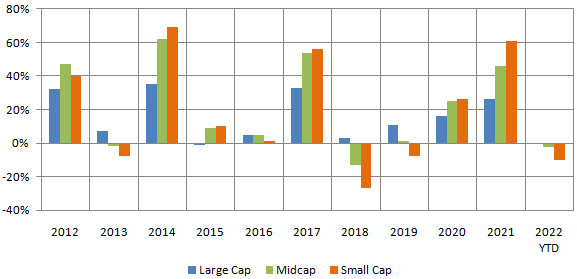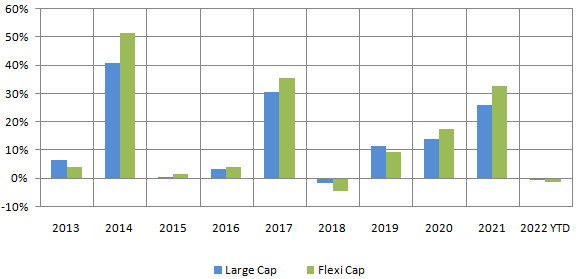Why you should have flexicap funds in your portfolio?

Flexicap fund is the one of the most popular categories of mutual funds in India. As per AMFI data, total assets under management (AUM) in flexicap funds, as on 29th July 2022, was more than Rs 2.3 lakh crores, almost the same as the AUM in large cap funds. Though the term flexicap as a category name is relatively new in India (as per SEBI circular in November 2020), diversified equity funds have been employed flexicap strategy for the longest period in the Indian mutual fund industry.
In this blog post, we will discuss about flexicap funds.
What are flexicap funds?
Flexicap funds are diversified equity mutual fund schemes which can invest across market cap segments. SEBI has no upper or lower limits with respect to allocations to any market cap segment as far as flexicap funds are concerned. This gives fund managers of flexicap schemes the freedom to invest in any market cap segment viz. large cap, midcap and small cap according to their market outlook.
Why invest in Flexicap Funds?
- Winners rotate across market cap segments: One market cap segment cannot keep outperforming or underperforming for a long time. Historical data shows that winners rotate across different market cap segments – see the chart below. Flexicap fund managers can create alphas by increasing / decreasingallocations to different market cap segments based on their outlook.
![Winners rotate across different market cap segments Winners rotate across different market cap segments]()
Source: NSE, Advisorkhoj Research (as on 29th July 2022). Large Cap: Nifty 100 TRI, Midcap: Nifty Midcap 150 TRI, Small Cap: Nifty Small Cap 250 TRI. Disclaimer: Past performance may or may not be sustained in the future.
- Greater scope of alpha creation compared to large cap: Large cap stocks have high percentage of institutional ownership, are more actively traded and therefore, have more efficient price discovery. Midcap and small cap stocks are less researched; Fund managers may be able to find quality mid and small cap stocks at attractive valuations, thereby creating higher alphas for investors over long investment horizons compared to large caps. Flexicap funds can create alphas through their midcap and small cap allocations, while large caps can provide stability.
The chart below shows the annual category average returns of Large Cap and Flexicap Funds over the last 10 years. You can see that flexicap funds, even though more volatile than large caps, were able to generate superior returns in most years.
![Annual category average returns of Large Cap and Flexicap Funds over the last 10 years Annual category average returns of Large Cap and Flexicap Funds over the last 10 years]()
Source: Advisorkhoj Research (as on 26th August 2022). Disclaimer: Past performance may or may not be sustained in the future.
- More stable than mid/small caps: As per SEBI’s regulations,midcap and small cap funds must invest minimum 65% of their assets in midcap (101st to 250th stocks by market cap) and small cap stocks (251st and smaller stocks by market cap) respectively. Flexicap funds, on the other hand, can have substantial allocations to large caps and can also increase / decrease allocations to different market cap segments depending on the outlook of their fund managers. The chart below shows the annual category average returns of Midcap, Small Cap and Flexicap Funds over the last 10 years. You can see that flexicap funds are more stable compared to midcaps and small caps.
![Annual category average returns of Large Cap and Flexicap Funds over the last 10 years Annual category average returns of Large Cap and Flexicap Funds over the last 10 years]()
Source: Advisorkhoj Research (as on 26th August 2022). Disclaimer: Past performance may or may not be sustained in the future.
- Ideal for retail investors: Prudent financial planning calls for diversification across all asset categories. Flexicap Funds are ideal for investors who cannot decide how much allocations they should have towards each market cap segments. The flexicap funds provide risk diversification as wealth creation for investors over long investment horizons. Many financial advisors recommend that flexicap funds should form the core of your long term investment portfolio. You can invest in the funds from your regular savings through monthly systematic investment plans.
Difference between Flexicap and Multicap Funds
Some investors may get confused between the two equity fund categories – flexicap and multicap funds, since both the fund categories invest across market cap segments. Some investors understand the differences between the categories, but are unable to decide between the two. We will discuss the main difference between the two categories, so that you can make informed investment decisions based on your risk appetite and investment needs.
- Flexicap funds can invest across all three market cap segments. There are no minimum or maximum limits for allocation to any market cap segment.
- Multicap funds must invest minimum 25% in large cap stocks, minimum 25% in midcap stocks and minimum 25% in small cap stocks.
- Large cap allocation of multicap funds cannot exceed 50%, since they have to invest minimum 25% in midcaps and minimum 25% in small caps.
- Large cap allocation in flexicap funds can exceed 50%, since there are no market cap specific limits in flexicap funds.
- Flexicap funds have greater ability / freedom to reduce risks based on their market outlook compared to small cap funds. For example, if the fund manager anticipates headwinds for equities in the near term, he / she can reduce mid / small cap allocations (which are more volatile) and the increase allocations to large cap (which are more stable). When the fund manager expects market to bottom, he / she can increase allocations to mid/small caps.
Who should invest in Flexicap Funds?
- Investors who want capital appreciation over long investment horizon.
- Investors with high to very high risk appetites.
- Investors who have at least 5 years plus investment tenures.
- Investors who want to invest from their monthly savings through SIP for their long term financial goals like children’s higher education, marriage, retirement planning, wealth creation etc.
- Investors who can invest in lump sum but ready to remain invested for the long term. Investors who are worried about short term volatility in the current environment, can invest in Flexicap Funds through 3 to 6 months STP.
Mutual Fund Investments are subject to market risk, read all scheme related documents carefully.
RECOMMENDED READS
Sundaram Asset Management Company is the investment manager to Sundaram Mutual Fund. Founded 1996, Sundaram Mutual is a fully owned subsidiary of one of India's oldest NBFCs - Sundaram Finance Limited.
Quick Links
- Interview - Mr. Dwijendra Srivastava - CIO - Fixed Income
- Interview - Mr. Sunil Subramaniam - CEO
- Sundaram Select Midcap Fund: Consistent outperformance makes it a big wealth creator
- Interview - Mr. Sunil Subramaniam - CEO
- Fund Manager Interview - Mr. Krishna Kumar - CIO - Equities
- Sundaram Rural India Fund: This thematic Mutual Fund aiming good long term returns
- Sundaram Equity Multiplier: Long term wealth creation potential
- Our Articles
- Our Website
- SIP one sheeter-Investor Education initiative
- Sundaram Asset Management Singapore
- Returns Calculator
- SEBI Investor Awareness Initiative
- Check your KYC Status
- KYC Forms & FAQs
- Recieve your PIN
- A note on NIGO
- FAQs on RGESS
- FAQs on Direct Plan
- Receive Updates
- Share your views
- Transmission Checklist
- Equity Application Form
- Fixed Income Application Form
- Transaction Slip
- Factsheet May - 2016
- MF Tax Reckoner 2015
Follow Sundaram MF
More About Sundaram MF
POST A QUERY







